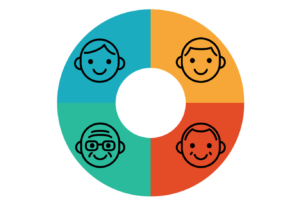Mapping the Life Stages of Alumni Donors

Most alumni won’t make a single gift during their lifetime. Fewer still will make a major or planned gift. Those alumni who do become donors will all give in their own unique way – through channels and at times that are right for them.
That said, it’s still important to recognize common giving patterns. It can help you, as a fundraiser, plan solicitations that will steadily increase a donor’s giving over time. One way to help you think about these giving patterns is to map out the stereotypical life stages of alumni donors:
- Before graduation, they make their first gift through the senior class gift campaign
- 1-15 years out, they make consistent donations to the annual fund
- 15-30 years out, they make leadership gifts to the annual fund
- 30+ years out, they make a major gift or planned gift
These stages suggest a model for cultivating alumni in a way that’s most likely to be in line with their own circumstances and capacity. For example, it’s probably not realistic to expect a recent graduate to be able to make a major gift since they are just starting out in their careers and in accumulating assets. Nor is it realistic to expect someone who has never donated before to make a major or planned gift if your institution has done nothing to build a relationship with them over time.
Encouraging alumni to move through these various stages also helps institutions build their donor pipelines, which is one of the most important functions of an annual giving program. This includes identifying and acquiring new donors, encouraging their consistent support, and raising their sights in a way that leads to their increased giving over time. A strong pipeline will ultimately produce a pool of prospects that have been regularly solicited, appropriately stewarded, and prepared for a conversation about a major or planned gift.
Make no mistake: every donor is unique with his or her own motives and interests. Cultivating relationships with donors based on their individual characteristics—and timing your solicitations accordingly—is fundamental and essential for successful fundraising. But it’s also important to be able to step back and see individual donors within a bigger context. Doing so can not only help you determine when it’s an appropriate time to ask for a gift, but it can also help you gauge when it’s the right time to go back and ask for more.
AGN Members receive unlimited access to our resources, discounts, and other benefits. Click here to learn more.
Want to stay up-to-date on best practices in annual giving? Click here to follow AGN's Page on Linkedin!
